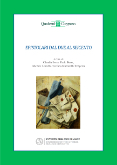
Pubblicato 22.12.2018
Parole chiave
- Carlo Gualteruzzi,
- lettere,
- Rinascimento,
- reti epistolari
Abstract
This article presents a preliminary analysis of the correspondence of Carlo Gualteruzzi (1500-1577), member of the Apostolic Penitentiary under Paul III and, in his later years, secretary to Cardinal Alessandro Farnese. Gualteruzzi spent his life in the service of the cultural, political and literary élite of Italian Renaissance. Major figures such as Pietro Bembo, Giovanni Della Casa, Vittoria Colonna, Marcantonio Flaminio and Ludovico Beccadelli were numbered among his friends, along with various poets and humanists who depended on his role as a source of information and as a promulgator and mediator of culture and poetry. The letters, drawn from unpublished documents held by libraries and archives in Italy and Europe, shine a light into the dense intellectual and political networks of the sixteenth century. The essay, which provides a general overview of Gualteruzzi’s letters, examines both the manuscript sources and the publication history of the letters. Lastly, it focuses on the role of Gualteruzzi as editor of several literary works (Giovanni Della Casa’s Galateo, the Novellino and Pietro Bembo’s posthumous writings).
